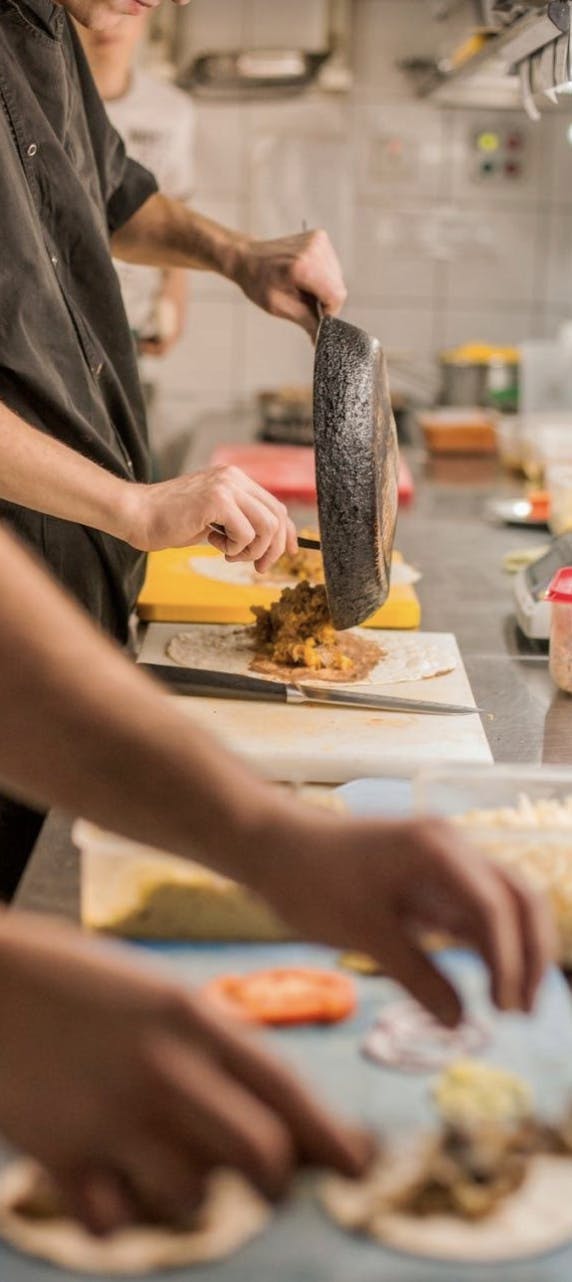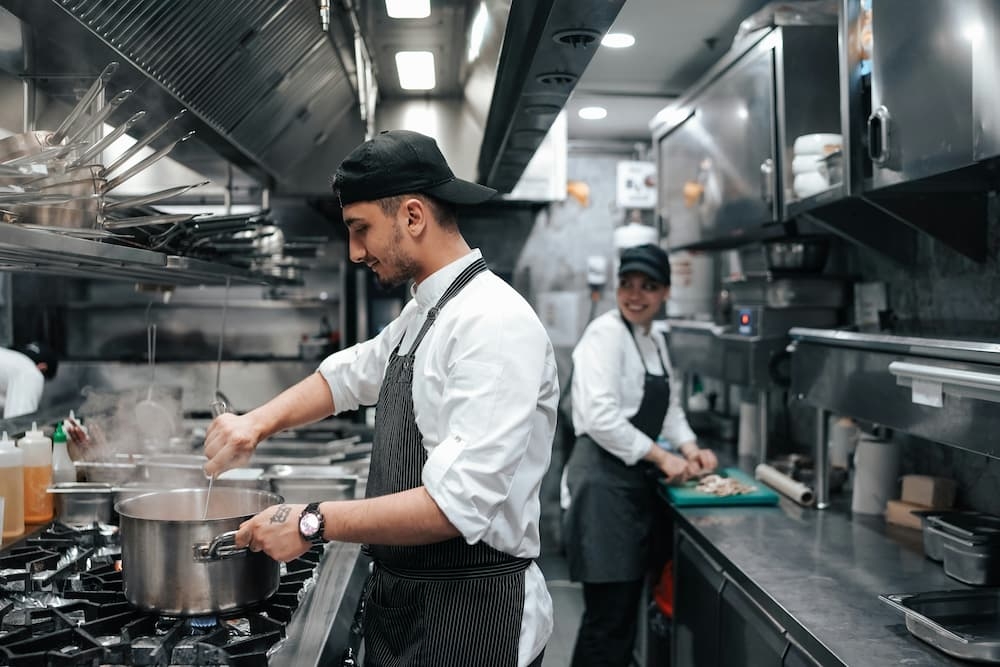Crafting memorable dining experiences in catering: strategies for success
Table of Contents
CloudKitchens
How many tacos can be delivered from a 1000sqft restaurant?
The same amount as a 200sqft ghost kitchen.
In the catering industry, delivering a memorable dining experience goes beyond serving great food. It’s about creating moments that resonate with your customers, whether through personalized service, innovative presentation, or seamless technology.
In this article, we’ll explore how catering businesses and ghost kitchens can elevate their dining experiences to build loyal customer bases, generate repeat business, and maximize profitability.
Key elements of a standout dining experience in catering
1. Personalization: Catering to customer preferences
Modern customers expect their dining experience to be tailored to their preferences. Personalization can include:
- Offering customizable menus that account for dietary restrictions, portion sizes, or specific cuisines.
- Using customer data to anticipate preferences and surprise guests with curated dishes.
- Providing options for meal kits or tailored event packages to give a bespoke touch.
By leveraging analytics tools, catering businesses can gather insights into popular menu items, peak ordering times, and customer feedback to fine-tune their services.
2. Innovative service styles
Traditional catering has evolved to include a variety of unique service methods. Businesses that embrace innovation stand out by:
- Interactive food stations: Creating live stations where chefs prepare dishes on the spot.
- Gourmet meal kits: Allowing customers to recreate restaurant-quality meals at home.
- Family-style dining: Offering large, shareable portions that create a communal dining experience.
- Virtual catering events: Integrating live chef-led cooking demos for corporate events or celebrations.
3. Premium presentation
The way food is presented, whether in person or through delivery, plays a crucial role in the customer experience. Invest in:
- High-quality packaging: Use eco-friendly, aesthetically pleasing packaging that ensures food arrives fresh and visually appealing.
- Attention to detail: Include handwritten thank-you notes, branded packaging, or thoughtful extras like dipping sauces or side dishes.
- Plating techniques: Even in delivery, customers appreciate artistic food presentation, elevating their perception of quality.
4. Ambience and storytelling
Whether catering an event or providing meals for home delivery, ambience matters. Consider:
- Sharing the story behind the dishes or the ingredients used in your menu.
- Adding unique design elements to your delivery packaging or virtual events.
- Offering playlists, decoration suggestions, or digital tools to help clients recreate an immersive atmosphere at home or during events.
Read more: 18 Catering Trends to improve your business success!
Integrating technology to enhance the experience
Technology plays a vital role in modern catering. The right tools can streamline operations and elevate the customer journey. Here’s how:
Online ordering platforms
Catering businesses that integrate online ordering platforms can:
- Simplify the ordering process with customizable menus and real-time availability.
- Manage high-volume orders efficiently with automated systems like CloudKitchens.
- Offer easy payment methods, reducing friction for customers.
Data analytics
Analytics allow catering businesses to understand customer behavior and preferences. By analyzing past orders, trends, and feedback, businesses can refine menus and pricing strategies, ultimately boosting sales.
Efficient delivery solutions
Seamless delivery is key to a successful catering business. Use delivery apps or third-party logistics solutions to ensure punctual, professional deliveries. Tracking tools and updates can keep customers informed and satisfied.
Read more: Restaurant Technology: Boost your business with the best technology trends
Trends shaping the dining experience in catering
The catering industry is rapidly evolving to meet the demands of modern customers. Here are some of the top trends to watch next year:
1. Sustainability
Today’s customers value eco-friendly practices. Caterers can align with this trend by:
- Using biodegradable packaging and utensils.
- Sourcing ingredients locally and prioritizing seasonal produce.
- Reducing food waste by offering portion-controlled options or donating leftovers.
2. Fine dining in catering
Catering businesses are embracing elements of fine dining, such as:
- Curating multi-course menus with wine pairings.
- Collaborating with renowned chefs to design signature dishes.
- Incorporating high-end plating and service techniques into catered events.
3. Immersive experiences
Customers are seeking more than just food, they want memorable moments. Immersive catering experiences might include:
- Themed menus that tie into cultural or seasonal events.
- Virtual cooking sessions with chefs for corporate team-building events.
- Engaging storytelling to connect customers with the dishes they’re enjoying.
4. Direct-to-consumer channels
More catering businesses are bypassing third-party platforms by investing in their own branded apps or websites. These channels offer:
- Greater control over customer data.
- Reduced commission fees compared to third-party apps.
- Opportunities to create loyalty programs and personalized promotions.
Read more: Ensure your catering business thrives: A guide to essential insurance for catering
Tips for ghost kitchens to elevate the dining experience
Ghost kitchens, also known as virtual kitchens, are redefining the catering landscape. With their delivery-focused model, they provide flexibility, scalability, and cost-effectiveness that traditional kitchens often lack.
For catering businesses operating under this model, here’s how you can elevate the dining experience to ensure customer satisfaction and drive long-term success:
1. Use technology to streamline operations
Efficiency is the backbone of a successful ghost kitchen. Integrating technology ensures smoother operations and an improved customer experience.
- Centralized management: Platforms like CloudKitchens provide a unified dashboard to manage multiple delivery services, track orders, and monitor performance metrics.
- Automated processes: Automating tasks like order confirmation, delivery scheduling, and menu updates minimizes human error and reduces turnaround time.
- Data-driven insights: Advanced analytics can help identify peak ordering times, top-performing menu items, and customer preferences, allowing businesses to adapt quickly and stay competitive.
- Inventory tracking: Utilize inventory management tools to monitor stock levels, preventing shortages and reducing waste.
2. Offer diverse menus under one roof
One of the most significant advantages of dark kitchens is the ability to operate multiple brands from a single location. This model enables you to:
- Cater to varied tastes: Offer a diverse range of cuisines, such as Italian, Asian, or plant-based options, to appeal to broader customer segments.
- Tap into niche markets: Introduce specialized brands that focus on specific customer needs, such as vegan, gluten-free, or family-style meals.
- Test new concepts: Experiment with new menus or dishes without the high risk of investing in a brick-and-mortar location.
- Seasonal offerings: Rotate your menu to include seasonal ingredients or limited-time dishes, keeping your offerings fresh and exciting.
3. Focus on Packaging and Delivery
Packaging and delivery are crucial touchpoints for dark kitchens to create a positive impression on customers. Poor packaging or delayed deliveries can ruin even the best meals. Here’s how to get it right:
- Invest in High-Quality Packaging: Use insulated, eco-friendly materials to keep food fresh and warm while demonstrating a commitment to sustainability.
- Enhance branding: Incorporate your logo, colors, or messaging on packaging to reinforce brand identity and make the dining experience memorable.
- Delivery accuracy: Use reliable third-party logistics or in-house drivers equipped with GPS tracking to ensure accurate and timely deliveries.
- Sealed for safety: Incorporate tamper-proof seals to build trust with customers and ensure food hygiene.
4. Gather and act on feedback
Customer feedback is invaluable for improving your operations and offerings. Make it easy for customers to share their opinions and act on them proactively.
- Incentivize reviews: Offer discounts or loyalty points for customers who leave feedback.
- Monitor ratings: Pay close attention to reviews on delivery platforms and social media to identify areas for improvement.
- Respond promptly: Address complaints quickly and professionally to build trust and loyalty.
- Iterate regularly: Use insights from customer feedback to update your menu, improve packaging, or enhance service quality.
5. Embrace the catering opportunity
Dark kitchens are increasingly catering to events, corporate meetings, and private gatherings. Expanding into catering services is an excellent way to grow your customer base and revenue.
- Customizable menus for events: Offer personalized catering packages that align with client needs, including corporate lunches, holiday parties, and weddings.
- Meal prep services: Provide pre-portioned meal kits for customers to recreate dishes at home, blending convenience with a touch of personalization.
- Virtual catering options: With the rise of remote work and virtual events, consider offering online catering solutions where meals are delivered individually to attendees’ homes.
6. Elevate the customer experience beyond food
To stand out, dark kitchens need to create an experience, not just a meal. Customers crave memorable interactions that extend beyond food quality.
- Loyalty programs: Build repeat business by offering rewards points, discounts, or exclusive deals for frequent customers.
- Surprise and delight: Include small, unexpected touches like complimentary desserts, hand-written thank-you notes, or discount codes for future orders.
- Personalized recommendations: Use customer data to suggest dishes based on order history, increasing satisfaction and upselling opportunities.
7. Collaborate with delivery platforms
Delivery apps like UberEats, DoorDash, and Grubhub play a critical role in the success of dark kitchens. Building strong partnerships with these platforms can enhance your reach and reputation:
- Optimize visibility: Work with platforms to ensure your brand is featured in relevant categories, such as “Healthy Eats” or “Family Meals.”
- Exclusive deals: Offer promotions or exclusive menu items on specific platforms to attract more customers.
- Track performance: Use analytics provided by these apps to track sales trends, customer reviews, and order accuracy rates.
Conclusion: CloudKitchens can help you deliver excellence
Creating an exceptional dining experience in catering requires a blend of creativity, personalization, and operational efficiency. CloudKitchens makes it easy for catering businesses to elevate their service with tools that connect delivery platforms, optimize order management, and provide actionable insights into customer behavior.
Ready to take your catering business to the next level? Let CloudKitchens empower you to craft unforgettable dining experiences while boosting your efficiency and profits. Get started today!
DISCLAIMER: This information is provided for general informational purposes only and the content does not constitute an endorsement. CloudKitchens does not warrant the accuracy or completeness of any information, text, images/graphics, links, or other content contained within the blog content. We recommend that you consult with financial, legal, and business professionals for advice specific to your situation.
More insights & stories
There’s more where that came from.
Get in the know and check out our additional insights


